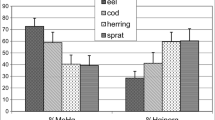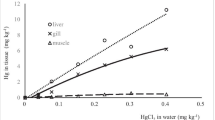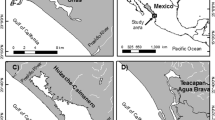Abstract
In the present study, we investigated the mercury distribution, mercury bioaccumulation, and oxidative parameters in the Neotropical fish Hoplias malabaricus after trophic exposure. Forty-three individuals were distributed into three groups (two exposed and one control) and trophically exposed to fourteen doses of methylmercury each 5 days, totalizing the doses of 1.05 μg g−1 (M1.05) and 10.5 μg g−1 (M10.5 group). Autometallography technique revealed the presence of mercury in the intestinal epithelia, hepatocytes, and renal tubule cells. Mercury distribution was dose-dependent in the three organs: intestine, liver, and kidney. Reduced glutathione concentration, glutathione peroxidase, catalase, and glutathione S-transferase significantly decreased in the liver of M1.05, but glutathione reductase increased and lipid peroxidation levels were not altered. In the M10.5, most biomarkers were not altered; only catalase activity decreased. Hepatic and muscle mercury bioaccumulation was dose-dependent, but was not influenced by fish sex. The mercury localization and bioaccumulation corroborates some histopathological findings in this fish species (previously verified by Mela et al. in Ecotoxicol Environ Saf 68:426–435, 2007). However, the results of redox biomarkers did not explain histopathological findings previously reported in M10.5. Thus, fish accommodation to the stressor may reestablish antioxidant status at the highest dose, but not avoid cell injury.



Similar content being viewed by others
References
Aebi H (1984) Catalase in vitro. Method Enzymol 105:121–126
Alvarado NE, Buxens A, Mazón LI, Marigómez I, Soto M (2005) Cellular biomarkers of exposure and biological effect in hepatocytes of turbot (Scophthalmus maximus) exposed to Cd, Cu and Zn and after depuration. Aquat Toxicol 74:110–125
Alves Costa JRM, Mela M, Silva de Assis HC, Pelletier E, Randi MAF, de Oliveira Ribeiro CA (2007) Enzymatic inhibition and morphological changes in Hoplias malabaricus from dietary exposure to lead (II) or methylmercury. Ecotoxicol Environ Saf 67:82–88
Aschner M (2002) Neurotoxic mechanisms of fish-borne methylmercury. Environ Toxicol Pharmacol 12:101–104
Baatrup E (1991) Structural and functional effects of heavy metals on the nervous system including sense organs of fish. Comp Biochem Physiol C 100:253–257
Baatrup E, Danscher G (1987) Cytochemical demonstration of mercury deposits in trout liver and kidney following methylmercury intoxication. Differentiation of two mercury pools by selenium. Ecotoxicol Environ Saf 14:129–141
Baatrup E, Nielsen MG, Danscher G (1986) Histochemical demonstration of two mercury pools in trout tissues: mercury in kidney and livers after mercuric chloride exposure. Ecotoxicol Environ Saf 12:267–282
Ballatori N (1991) Mechanisms of metal transport across liver cell plasma membranes. Drug Metabol Rev 23:83–132
Bastos WR, Malm O, Pfeiffer WC, Cleary D (1998) Establishment and analytical quality control of laboratories for Hg determination in biological and geological samples in the Amazon Brazil. Ciência e Cultura 50:255–260
Berntssen MHG, Aatland A, Handy RD (2003) Chronic dietary mercury exposure causes oxidative stress, brain lesions, and altered behaviour in Atlantic salmon (Salmo salar) parr. Aquat Toxicol 65:55–72
Bidone ED, Castilhos ZC, Santos TJS, Souza TMC, Lacerda LD (1997) Fish contamination and human exposure to mercury in Tartarugalzinho River, Amapa State, Northern Amazon, Brazil: a screening approach. Water Air Soil Pollut 97:9–15
Boischio AA, Henshel DS (1996) Risk assessment of mercury exposure through fish consumption by the riverside people in the Madeira basin Amazon. Neurotoxicology 17:169–176
Bradford MM (1976) A rapid and sensitive method for the quantification of microgram quantities of protein using the principle of protein dye binding. Anal Biochem 72:248–254
Bridges CC, Zalups RK (2005) Molecular and ionic mimicry and the transport to toxic metals. Toxicol Appl Pharmacol 204:274–308
Clarkson TW (2002) The three modern faces of mercury. Environ Health Perspect 110:11–23
Cookson MR, Pentreath VW (1996) Protective roles of glutathione in the toxicity of mercury and cadmium compounds to C6 glioma cells. Toxicol In Vitro 10:257–264
Crouch RK, Gandy SC, Kimsey G (1981) The inhibition of islet superoxide dismutase by diabetogenic drugs. Diabetes 30:235–241
Danscher G, Möller-Madsen B (1985) Silver amplification of mercury sulphide and selenide. A histochemical method for light and electron microscopic localization of mercury in tissue. J Histochem Cytochem 33:219–228
Danscher G, Nørgaard JOR (1983) Light microscopic visualization of colloidal gold on resin-embedded tissue. J Histochem Cytochem 31:1394–1398
Danscher G, Stoltenberg M, Bruhn M, Søndergaard C, Jensen D (2004) Immersion autometallography: histochemical in situ capturing of zinc ions in catalytic zinc–sulfur nanocrystals. J Histochem Cytochem 52:1619–1625
De Flora S, Bennicelli C, Bagnasco M (1994) Genotoxicity of mercury compounds. A review. Mutat Res 317:57–79
Dorea JG, Barbosa AC, Silva GS (2006) Fish mercury bioaccumulation as a function of feeding behavior and hydrological cycles of the Rio Negro Amazon. Comp Biochem Physiol C 142:275–283
Elia AC, Galarini R, Taticchi MI, Dörr AMJ, Mantilacci L (2003) Antioxidant responses and bioaccumulation in Ictalurus melas under mercury exposure. Ecotoxicol Environ Saf 55:162–167
Filipak Neto F, Zanata SM, Silva de Assis HC, Nakao LS, Randi MAF, Oliveira Ribeiro CA (2008) Toxic effects of DDT and methyl mercury on the hepatocytes from Hoplias malabaricus. Toxicol In Vitro 22:1705–1713
Handy RD (1993) The effect of acute-exposure to dietary Cd and Cu on organ toxicant concentrations in rainbow trout, Oncorhynchus mykiss. Aquat Toxicol 27:1–14
Jiang ZY, Woollard ACS, Wolff SP (1991) Lipid hydroperoxides measurement by oxidation of Fe2+ in the presence of xylenol orange comparison with the TBA assay and an iodometric method. Lipids 26:853–856
Keen JH, Habig WH, Jakoby WB (1976) Mechanism for several activities of the glutathione S-transferases. J Biol Chem 251:6183–6188
Kirubagaran R, Joy KP (1988) Toxic effects of three mercurial compounds on survival, and histology of the kidney of the catfish Clarias batrachus (L.). Ecotoxicol Environ Saf 15:171–179
Klaassen CD (2006) Heavy metals and heavy-metal antagonists. In: Brunton LL, Lazo JS, Parker KL (eds) The pharmacological basis of therapeutics. McGraw- Hill, New York, pp 1753–1755
Kojima K, Fujita M (1973) Summary of recent studies in Japan on methyl mercury poisoning. Toxicology 1:43–62
Konigsberg M, Lopez-Diazguerrero NE, Bucio L, Gutierrez-Ruiz MC (2001) Uncoupling effect of mercuric chloride on mitochondria isolated from a hepatic cell line. J Appl Toxicol 21:323–329
Leaner JJ, Mason RP (2004) Methylmercury uptake and distribution kinetics in Sheepshead minnows, Cyprinodon variegatus, after exposure to CH3HG-spiked food. Environ Toxicol Chem 23:2138–2146
Lebel J, Mergler D, Branches F, Lucotte M, Amorim M, Larribe F, Dolbec J (1998) Neurotoxic effects of low-level methylmercury contamination in the Amazonian Basin. Environ Res 79:20–32
Loumbourdis NS, Danscher G (2004) Autometallographic tracing of mercury in frog liver. Environ Pollut 129:299–304
Maury-Brachet R, Gilles D, Yannick D, Alain B (2006) Mercury distribution in fish organs and food regimes: significant relationships from twelve species collected in French Guiana (Amazonian basin). Sci Total Environ 368:262–270
Mela M, Randi MA, Ventura DF, Carvalho CE, Pelletier E, Oliveira Ribeiro CA (2007) Effects of dietary methylmercury on liver and kidney histology in the neotropical fish Hoplias malabaricus. Ecotoxicol Environ Saf 68:426–435
Mela M, Cambier S, Mesmer-Dudons N, Legeay A, Grotzner SR, Oliveira Ribeiro CA (2010) Methylmercury localization in Danio rerio retina after trophic and subchronic exposure: a basis for neurotoxicology. Neurotoxicology 31:448–453
Mela M, Grotzner SR, Legeay A, Mesmer-Dudons N, Massabau J-C, Ventura DF, Oliveira Ribeiro CA (2012) Morphological evidence of neurotoxicity in retina after methylmercury exposure. Neurotoxicology 33:407–415
Miranda AL, Roche H, Randi MAF, Menezes ML, Oliveira Ribeiro CA (2008) Bioaccumulation of chlorinated pesticides and PCBs in the tropical freshwater fish Hoplias malabaricus: histopathological, physiological, and immunological findings. Environ Int 34:939–949
Mol JH, Ramlal JS, Lietar C, Verloo M (2001) Mercury contamination in freshwater, estuarine, and marine fishes in relation to small-scale gold mining in Suriname, South America. Environ Res 86:183–197
Monserrat JM, Martínez PE, Geracitano LA, Amado LL, Martins CMG, Pinho GLL, Chaves IS, Ferreira-Cravo M, Ventura-Lima J, Bianchini A (2007) Pollution biomarkers in estuarine animals: critical review and new perspectives. Comp Biochem Physiol C 146:221–234
Moura Costa DD, Filipak Neto F, Costa MDM, Morais RN, Garcia JRE, Esquivel BM, Oliveira Ribeiro CA (2010) Vitellogenesis and other physiological responses induced by 17-β-estradiol in males of freshwater fish Rhamdia quelen. Comp Biochem Physiol C 151:248–257
Nordberg GF, Skerfving S (1972) Metabolism. In: Friberg L, Vostal D (eds) Mercury in the environment. CRC Press, Cleveland, pp 29–91
Oliveira Ribeiro CA, Rouleau C, Pelletier E, Audet C, Tjalve H (1999) Distribution kinetics of dietary methylmercury in the artic charr (Salvelinus alpinus). Environ Sci Technol 33:902–907
Oliveira Ribeiro CA, Belger L, Pelletier É, Rouleau C (2002) Histopathological evidence of inorganic mercury and methyl mercury toxicity in the arctic charr (Salvelinus alpinus). Environ Res 90:217–225
Oliveira Ribeiro CA, Filipack Neto F, Mela M, Silva PH, Randi MAF, Costa JRA (2006) Hematological findings in neotropical fish Hoplias malabaricus exposed to subchronic and dietary doses of methylmercury, inorganic lead and tributyltin chloride. Environ Res 101:74–80
Pritchard JB, Bend JR (1984) Mechanisms controlling the renal excretion of xenobiotics in fish: effects of chemical structure. Drug Metab Rev 15:655–671
Qiu G, Feng X, Wang S, Fu X, Shang L (2009) Mercury distribution and speciation in water and fish from abandoned Hg mines Wanshan, Guizhou province, China. Sci Total Environ 407:5162–5168
Rabitto IS, Bastos WR, Almeida R, Anjos A, Barbosa de Holanda IB, Galvão RCF (2011) Mercury and DDT exposure risk to fish-eating human populations in amazon. Environ Int 7:56–65
Sanfeliu C, Sebastià J, Cristòfol R, Rodríguez-Farré E (2003) Neurotoxicity of organomercurial compounds. Neurotox Res 5:283–305
Sassa S (1982) Delta-aminolevulinic acid dehydratase assay. Enzyme 28:133–145
Scudder BC, Chaser LC, Wentz DA, Bauch NJ, Brigham ME, Moran PW (2009) Mercury in fish, bed sediment, and water from streams across the United States, 1998–2005. Reston, Virginia, p 74
Sedlak J, Lindsay RH (1968) Estimation of total protein bound and nonprotein sulphydril groups in tissues with Ellman’s reagent. Anal Biochem 25:192–205
Shi J-Z, Kanga F, Wu Q, Lu Y-F, Liu J, Kang YJ (2011) Nephrotoxicity of mercuric chloride, methylmercury and cinnabar-containing Zhu-Sha-An-Shen-Wan in rats. Toxicol Lett 200:194–200
Sies H, Koch OR, Martino E, Boveris A (1979) Increased biliary glutathione disulfide release in chronically ethanol-treated rats. FEBS Lett 103:287–290
Silva GS, Filipak Neto F, Silva de Assis HC, Bastos WR, de Oliveira Ribeiro CA (2012) Potential risks of natural mercury levels to wild predator fish in an Amazon reservoir. Environ Monit Assess 184:4815–4827
Soto M, Quincoces I, Marigomez I (1998) Autometallography procedure for the localization of metal traces in molluscan tissues by light microscopy. J Histotechnol 21:123–127
Stohs SJ, Bagchi D (1995) Oxidative mechanisms in the toxicity of metals ions. Free Radic Bio Med 2:321–336
Suzuki T (1977) Metabolism of mercurial compounds. In: Goyer RA, Mehlaman MA (eds) Toxicology of trace elements. Halsted Press, New York, pp 1–39
Takahashi K (1994) Glutathione peroxidase, coupled enzyme assay. In: Taniguchi N, Gutteridge JMC (eds) Experimental protocols for reactive oxygen and nitrogen species. Oxford University Press, London, pp 79–80
Thompson DR (1990) Metal levels in marine vertebrates. In: Furness RW, Rainbow PS (eds) Heavy metals in the marine environment. CRC Press, Boca Raton, pp 143–182
Ung CY, Lam SH, Hlaing MM, Winata CL, Korzh S, Mathavan S, Gong Z (2010) Mercury-induced hepatotoxicity in zebrafish: in vivo mechanistic insights from transcriptome analysis, phenotype anchoring and targeted gene expression validation. BMC Genomics 11:212
Velisek J, Stara A, Kolarova J, Svobodova Z (2011) Biochemical, physiological and morphological responses in common carp (Cyprinus carpio L.) after long-term exposure to terbutryne in real environmental concentration. Pest Biochem Physiol 100:305–313
Wester PW, Canton HH (1992) Histopathological effects in Poecilia reticulate (Guppy) exposed to methyl mercury chloride. Toxicol Pathol 20:81–92
WHO (1990) World Health Organization. Environmental Health Criteria 101. Methylmercury. World Health Organization, Geneve, Switzerland
Won Lee J, Won Kim J, De Riu N, Moniello G, Hung SSO (2012) Histopathological alterations of juvenile green (Acipenser medirostris) and white sturgeon (Acipenser transmontanus) exposed to graded levels of dietary methylmercury. Aquat Toxicol 109:90–99
Woods AE, Ellis RC (1994) Laboratory histopathology: a complete reference, 1st edn. Churchill Livingstone Publishers, New York
Yee S, Choi B (1996) Oxidative stress in neurotoxic effects of methylmercury poisoning. Neurotoxicology 17:17–26
Zaman K, Pardini R (1996) An overview of the relationship between oxidative stress and mercury and arsenic. Toxic Subst Mech 15:151–181
Acknowledgments
This study was supported by Conselho Nacional de Desenvolvimento Científico e Tecnológico (CNPq), a Brazilian Agency for Scientific and Technology Development.
Author information
Authors and Affiliations
Corresponding author
Rights and permissions
About this article
Cite this article
Mela, M., Neto, F.F., Yamamoto, F.Y. et al. Mercury distribution in target organs and biochemical responses after subchronic and trophic exposure to Neotropical fish Hoplias malabaricus . Fish Physiol Biochem 40, 245–256 (2014). https://doi.org/10.1007/s10695-013-9840-4
Received:
Accepted:
Published:
Issue Date:
DOI: https://doi.org/10.1007/s10695-013-9840-4




